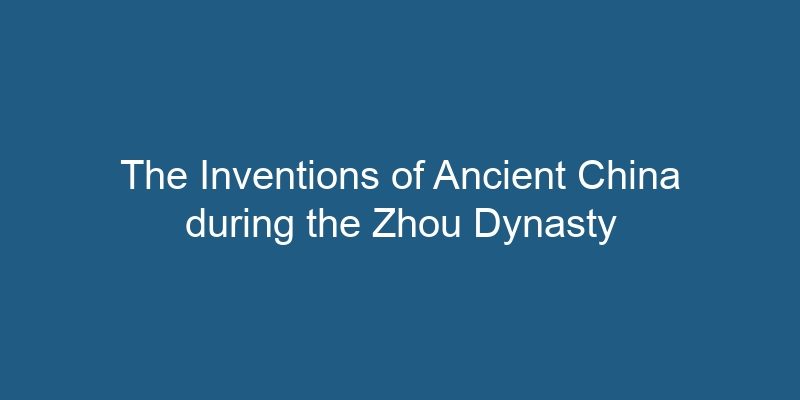The Zhou Dynasty (1046-256 BCE) was a significant period in Chinese history, characterized by political, social, and technological advancements. During this time, China experienced numerous inventions and innovations that greatly influenced not only its own development but also the progress of other civilizations. In this article, we will explore some of the remarkable inventions of ancient China during the Zhou Dynasty.
1. Iron Casting
Iron casting was one of the most notable technological advancements during the Zhou Dynasty. The ability to cast iron in large quantities revolutionized various industries, including agriculture, warfare, and construction. The Zhou people developed advanced techniques for smelting iron, resulting in more durable and versatile tools and weapons.
The process of iron casting involved heating iron ore in a furnace until it melted, and then pouring the molten iron into molds. This allowed the production of various iron implements such as plows, axes, swords, and spearheads. Iron casting played a crucial role in increasing agricultural productivity, leading to advancements in farming techniques and yielding more abundant harvests.
2. Crossbow
The invention of the crossbow during the Zhou Dynasty revolutionized warfare and greatly enhanced the military capabilities of ancient China. The crossbow was a powerful and deadly weapon that could be operated by a single person, making it easier to train and deploy large armies.
The crossbow was constructed with a mechanism that allowed the user to draw back the bowstring and lock it in place, significantly increasing the force and accuracy of the shot. This innovation provided a significant advantage in battles, as crossbowmen could shoot arrows over longer distances and with greater force compared to traditional bows.
3. Paper
Another pivotal invention during the Zhou Dynasty was the creation of paper. The Zhou people developed a method for making paper by grinding plant fibers, such as mulberry bark and hemp, into a pulp and then pressing and drying it into thin sheets.
Prior to the invention of paper, ancient Chinese civilizations used various materials for writing, such as bamboo strips, silk, and animal bones. The introduction of paper revolutionized the dissemination of knowledge and information, as it was more affordable, portable, and easier to produce. This invention had a profound impact on education, administration, and cultural development in China.
4. Silk Production
The Zhou Dynasty witnessed significant advancements in silk production, which played a crucial role in shaping Chinese culture and trade. Silk, a luxurious and highly sought-after fabric, was originally produced exclusively by the Chinese.
The process of silk production involved raising silkworms and harvesting their cocoons. The cocoons were then carefully unraveled to obtain the silk threads, which were spun into yarn and woven into fabric. The intricate techniques used in silk production were a closely guarded secret in ancient China, allowing the Chinese to maintain a monopoly on silk for centuries.
5. Decimal System
The Zhou Dynasty also saw the development of the decimal system in China. This numerical system, based on powers of ten, greatly simplified mathematical calculations and facilitated advancements in various fields, including astronomy, engineering, and commerce.
Prior to the decimal system, ancient Chinese used a system of counting with rods or knots. The introduction of the decimal system, which included the concept of zero, allowed for more efficient and accurate calculations. This innovation laid the foundation for the further development of mathematics in China.
6. Coinage
During the Zhou Dynasty, the Chinese also introduced standardized coinage, which greatly facilitated trade and economic transactions. Prior to the use of coins, ancient Chinese civilizations relied on bartering and the exchange of goods.
The standardized coins were made of bronze and featured distinct shapes and inscriptions to denote their value and origin. This system of coinage provided a common medium of exchange and allowed for more efficient trade within the Zhou Dynasty and beyond.
7. Water Clock
The Zhou Dynasty is also credited with the invention of the water clock, a device used to measure time by the flow of water. The water clock played a crucial role in various aspects of ancient Chinese life, including agriculture, astronomy, and administrative tasks.
The water clock consisted of a container filled with water that gradually emptied through a small hole. Markings on the container indicated the passing of time as the water level dropped. This invention allowed for more accurate timekeeping and improved the efficiency of various activities that required precise timing.
Conclusion
The Zhou Dynasty of ancient China was a period marked by remarkable inventions and technological advancements that shaped not only Chinese civilization but also influenced the progress of other societies. From iron casting and the crossbow to paper and silk production, these inventions revolutionized various aspects of life, including warfare, education, trade, and timekeeping. The legacy of these inventions continues to resonate in modern-day China and serves as a testament to the ingenuity and innovative spirit of the ancient Chinese people.










